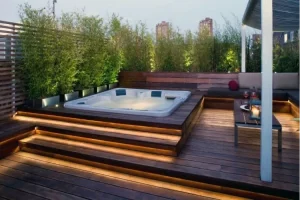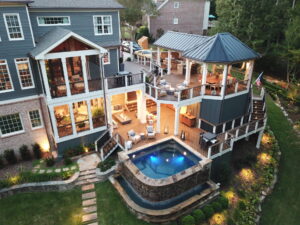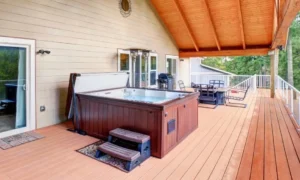Above Ground Pool Deck Ideas on a Budget
By Dave Kile It’s no wonder that above-ground pools make up nearly 60% of all pools in the U.S. They’re budget-friendly, easy to install, and perfect for turning any backyard into a private oasis. Pair one with a well-designed pool deck, and suddenly you’ve transformed your outdoor space into a resort-worthy retreat – no spa appointment necessary!
It’s no wonder that above-ground pools make up nearly 60% of all pools in the U.S. They’re budget-friendly, easy to install, and perfect for turning any backyard into a private oasis. Pair one with a well-designed pool deck, and suddenly you’ve transformed your outdoor space into a resort-worthy retreat – no spa appointment necessary!
This article will provide affordable deck design ideas for building and accessorizing a deck around an above-ground pool that won’t drain your wallet.
Affordable Above-Ground Deck Ideas
Most above-ground pool walls are not structural. Attaching a deck directly to any pool has the potential to cause damage and will almost certainly require complex installation. For affordability, ease of installation, and safety, floating decks are by far the most common and recommended option to surround above-ground pools.
Floating decks should be built adjacent to the pool. They’re typically supported by concrete blocks or piers, not the deep-set footings typically used on a traditional deck attached to a house. Floating decks can be simple platforms slightly off the ground or can be built at the same level as the pool. For decks flush with the pool walls, keep in mind you’ll most likely need to add railing and stairs or a ramp to make the pool accessible.
The shape of your above-ground pool will significantly impact the cost and complexity of your deck build. Here are some thoughts to help you choose the design of your pool deck:
Single-Side Platform Deck
A single-sided platform deck is the easiest option for building a deck around an above-ground pool. This design works best aesthetically with a square or rectangular pool rather than a round one.
Quarter-Wrap Deck
A quarter-wrap pool deck (also known as a quarter-round), is designed to surround a portion of the pool’s perimeter. It is most commonly used for round above-ground pools. This type of pool deck provides usable space without fully wrapping the pool, saving a considerable amount of money. It is ideal for a small seating area and provides easy access to the pool.
Since round pools are the most popular above-ground pool design, a quarter-wrap is a good solution for adding the functionality of a pool deck without the cost of a fully wrapped one.
L-Shaped Deck
For two connected rectangular pools, an L-shaped deck is a smart move. It provides access to both sides of the pool. Consider using one side for pool access and the other for lounging.
Narrow Walkway
A fun and affordable solution is to build a narrow walkway, 2’ to 3’ wide, around the entire perimeter of the pool. This works especially well in small backyards, providing pool access without taking up a lot of space.
These charming, minimalist walkways are a good option for narrow lap pools, providing just enough space for access and sunbathing.
Tiered, Multi-Level Deck

For sloped yards, a more elaborate tiered or multi-level pool deck can solve topography issues while creating activity zones. Tiered decks make an excellent solution for yards with elevation challenges and can also help add visual interest to just about any outdoor area. And with a multi-level deck, you can easily create different zones for distinct activities (like lounging, entertaining, and more).
Tiered deck structures allow you to easily incorporate a hot tub and pool together in one space while allowing each to shine. It also may give you space to incorporate storage for all those pool accessories.
Designing a multi-tiered deck is a bit more complicated than your average outdoor setup and may require the help of a contractor or pool builder. You’ll want a well-planned design that provides easy access to the water while allowing everyone to move around safely.
Budget-Friendly Materials for Pool Decks
Just like a deck attached to a house, pool decks can be built with a variety of low-cost materials. Choose the material that best fits your style and budget.
Pressure-Treated Wood
Pressure-treated lumber is the most popular, readily available, and affordable choice for a deck built around an above-ground pool. Pressure-treated wood can be purchased at most lumberyards and home centers, is easy to work with, and costs about $1-$2 per linear foot.
The downside of a pressure-treated deck is the heavy maintenance requirements to keep the deck safe and looking good over time. Unlike competitive materials such as wood-plastic composites, pressure-treated wood will last approximately 10-15 years, provided it receives diligent maintenance. Wood requires sealing and staining every 1-2 years and also tends to splinter and warp over time without careful attention. This can cause safety issues for a pool deck, where swimmers and sunbathers are often barefoot..
Wood-Plastic Composite
A great alternative to wood and premium composites is entry-level wood-plastic composite decking. These boards, made from an eco-friendly mix of recycled plastic film and reclaimed wood, cost just slightly more than wood at about $2-$5 per linear foot.
Entry-level composite decking collections like Trex Enhance and Trex Select last 25 to 35 years with little maintenance hassles. Unlike wood, composites require only a soap and water cleanup to keep them looking like new. Composites won’t rot, splinter, or disintegrate from water, making them desirable for pool decks.
Like any other outdoor material, composites can become hot when exposed to direct sunlight (especially during summer). Lighter colors tend to stay cooler than darker hues. Some newer composites are made with heat-mitigating technology, making them perfect for barefoot, poolside activities.
Composites cost more initially than pressure-treated wood, but you can recoup the cost within a few years.
Wood Pallets
With the rise of the DIY culture in the mid-2010s, shipping pallets gained traction as a building material for backyard projects. Affordable and eco-friendly, reclaimed wood can offer a quick and relatively easy way to build a pool deck.
Pallets made from softwoods are a good solution for smaller budgets, as they’re often easily obtainable at no or low cost. Building the deck from these standard 48 ”x 40” platforms can also be a fun family project.
Pallets may not make the best long-term solution, as their softwood materials make them more susceptible to moisture and rot. Their aesthetic, as well as the extensive care and cleaning required to use them safely, might not suit everyone’s taste.
Finishing off the space around your above-ground pool deck doesn’t have to break the budget. Here are a few cost-effective landscaping and design ideas that combine creativity with simplicity to enhance your backyard enjoyment.
Mulch Beds
It doesn’t get much easier to beautify your pool and deck than to mulch beds around the perimeter. At about $3-$5 a bag, you can create a soft edge around your pool deck, subdue weeds, and accent plants and flowers in an afternoon. Enhance your space with a few native shrubs, vibrant flowers, or ornamental grasses. Earthy dark brown or contemporary black mulch creates a clean, simple look, while red and gold mulch adds flair.
Decorative Gravel or River Rock
Decorative gravel and river rock are standard, low-maintenance, and affordable ground covers to accent your pool and deck. Used to define landscaping beds, control erosion and weeds, and add decorative texture and visual interest, gravel, rock, and stones won’t decompose like mulch and can often deflect light and heat away from the pool.
Bags of gravel and river rock typically cost $4-$8, but you can also buy them in bulk to save money. To reduce maintenance and the need for weeding, consider applying a weed barrier or landscaping fabric beneath rocky areas. Consider mixing sizes, such as blending smooth pea gravel with larger, angular limestone, and use metal, stone, or plastic edging to contain them within the border. You can even combine pavers, stone, and rocks for a fun variation.
Solar Lights
Nothing enhances an outdoor space like landscape lighting. For an affordable option, consider solar lights, which typically cost $1-$4 per light and are available in multi-pack boxes at home improvement and hardware stores.
Light your pathway edges and any railing post tops, or shine a spotlight to accent plants and flowers. Lights not only help set a scene, but also add critical safety features (especially for those night swims!).
Container Gardens and Planters
Adding greenery and color with plants and flowers can bring a touch of whimsy and enjoyment to your above-ground pool deck. Consider additions like ornamental grasses, colorful perennials, and native annuals.
Planters of all sizes can be purchased at hardware stores. You can also find affordable options at second-hand shops and online marketplaces. Consider using old buckets, plastic storage bins, and wooden crates for even more budget-friendly solutions.
Affordable Privacy Options
If you have neighbors nearby, consider creating an affordable privacy screen around your above-ground pool deck. A fence is the obvious option, but other, more inexpensive solutions include:
- Incorporating a tall planter or narrow evergreen. At $20-$50 each, one or two may be all you need to add an element of seclusion
- Tying bamboo stalks to an existing fence for a vacation vibe
- Adding a trellis with climbing clematis vines and installing it behind the deck for vertical greenery
- Hanging an outdoor curtain or drop cloth (mounted on a conduit or rope between posts) to add shading or create a resort feel
Affordable Extras
- Facebook Marketplace, Craigslist, and similar neighborhood social sites are great resources for free planters and other landscaping material that others are looking to pass along
- Visit local landscapers for bulk mulch, gravel, and stone, which are less expensive than individual bags
- Keep an eye out for end-of-season sales at garden centers
- Consider using repurposed furniture as plant stands. For something new, you can try upcycling an old chair into a plant container
Tips for Planning And Building On A Budget
Careful planning will allow you to build your above-ground deck within budget. Here are some additional tips to ignite your creativity.
- Tackle your project in stages. Start small and expand as the budget allows
- Squares and rectangular deck designs require fewer cuts, resulting in less material waste. While aesthetically pleasing, curves and custom shapes add complexity and cost
- Give careful planning to building your deck lower to the ground if your site allows it. In most localities, you can avoid railing, stairs, and ramps if your deck is less than 30” off the ground. That will cut costs, requiring less lumber, fasteners, and labor
- Scour salvage yards and yard sales for inexpensive material and decor. Facebook Marketplace, Craigslist, and other local social sites are good places to find reclaimed wood and gently used decorations
- Shop off-season at lumberyards and other retail centers. Enjoy the journey as much as the destination, and experience joy and contentment as you build your backyard oasis
- Pressure-treated lumber costs less up front, but requires more labor and maintenance over time. Prioritize what is most important before you start buying
- If you have construction skills, consider building the deck yourself! Labor is typically two-thirds of the cost of any deck project, so this option has the potential to net you serious savings. There are plenty of resources like Trex Academy to help you navigate the installation process. Decks.com also offers free deck plan template, and home center websites offer deck planning tools
Safety & Codes
Don’t skimp when it comes to obtaining the necessary permits to build your deck. Check with your local building department and Homeowners Association for approvals. Failing to comply with local regulations could result in fines that exceed the cost of obtaining a permit, so ensure you complete your due diligence.
Pool builds have their own special set of regulations. Lockable gates and barriers may be necessary to keep you and your family safe, as well as to keep unwanted visitors out. It’s never wise to ignore these requirements, so factor them into your budget from the start.
Frequently Asked Questions
How Long Do Budget Decks Last?
The lifespan of an above-ground pool built on a budget will depend significantly on the materials chosen, construction quality, and maintenance. A deck built from pressure-treated lumber can last 10-15 years with regular sanding and sealing, while budget-friendly composite boards are warrantied for 25-35 years. Pallets and reclaimed wood generally last 3-7 years and require extensive upkeep – so be sure to factor maintenance into your deck build plan.
What is the Cheapest Way to Build a Pool Deck?
You can save money on your pool deck project by:
- Choosing a design that requires less structural support and fewer deck boards
- Using affordable or repurposed materials
- Building the deck yourself (if you have the skills and time)
Are There Maintenance Tricks to Keep it Looking New Without Spending Too Much?
To keep your deck safe and looking good without breaking the bank, consider regular cleaning. A solution of vinegar, baking soda, and warm water can prevent mold and mildew from building on a wood deck. Spot treat stains immediately and check for loose fasteners regularly. Consider using a rug to protect the boards. And sand and stain a wood deck every 1-2 years for best results. Composite boards cost more upfront, but will last far longer than wood, while requiring only periodic cleanup with soap and water.
Final Thoughts
A functional and attractive deck built around an above-ground pool is possible even on a budget. With some wise planning and a little ingenuity, you and your family can enjoy a fun and affordable backyard project that will enhance your summer pool experience and create memories that last a lifetime.

